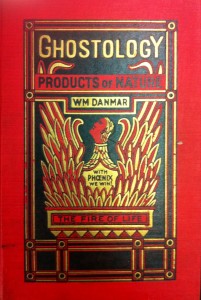The bulk of the ghost books in the Gleason collection are simply assemblages of ghost tales, both popular and personal. Some limit themselves to recounting the tales, while others seek to explain the m, either by upholding their veracity or seeking to provide rational interpretations. Others, such as Ghostology by William Danmar, are a serious-minded and vigorous argument for the existence of ghosts. Others still tend to be more fanciful and tend to romanticize the idea of ghosts and occult beings, such as Elliot O’Donnell’s Byways of Ghostland. The titles below represent the tenor of the collection but are not a complete list.
m, either by upholding their veracity or seeking to provide rational interpretations. Others, such as Ghostology by William Danmar, are a serious-minded and vigorous argument for the existence of ghosts. Others still tend to be more fanciful and tend to romanticize the idea of ghosts and occult beings, such as Elliot O’Donnell’s Byways of Ghostland. The titles below represent the tenor of the collection but are not a complete list.
Historic Ghosts and Ghost Hunters
H. Addington Bruce
New York: Moffat Yard, 1908. [First edition.]
Summary: In this book, H. Addington Bruce outlines 11 famous ghost stories and ghost hunters and seeks to offer rational explanations for the extraordinary events described in each story. Occasionally his “rational” explanation is telepathy. Addington seeks to debunk ghost tales, but demonstrates himself to be willing to occasionally accept the supernatural. The author wrote a previous work on spiritualist topics, “The Riddle of Personality. “From his earliest youth, his father, a most matter of fact person, sedulously endeavored to impress him with the belief that the only spirits deserving of the name were those which came in oddly labeled bottles” Chapter 6, “The Ghost Seen By Lord Brougham,” (103).
C. G. Harper.
London: C. Palmer, 1907 [Our edition published 1927, 3rd].
Summary: The author surveys several supposedly haunted locations, gives a description of the ghosts and myths that surround the places, and gives commentary on the relative credibility of the tales. “The ancient sense of human life beset on all sides by heavenly watchers and diabolic enemies is not extinct. It lies dormant and forgotten, but ready at call when occasion comes; and so, too, the deep-seated belief in the spirit-world is proof against any boast of disbelief.”
Elliot O’Donnell
London: W. Rider, 1911 [First edition.]
Summary: O’Donnell presents a comprehensive guide to all the inhabitants of Ghostland. He outlines supernatural creatures such as Banshees and werevolves and also describes occult symbols, such as the Hand of Glory. O’Donnell discusses hauntings and ghosts at depth, offering several personal stories as examples. Though O’Donnell describes the events as true, certainly most if not all of them were likely made up as a literary ploy. One of the most engaging and entertaining books in the collection. “Whether all that constitutes man’s spiritual nature, that is to say, ALL his mind, is inseparably amalgamated with the whitish mass of soft matter enclosed in his cranium and called his brain, is a question that must, one supposes, be ever open to debate.” (1)
A.M.W. Stirling
New York: Citadel, 1958 [First edition.]
Summary: A.M.W Stirling wrote this book near the end of her life in an attempt to study and learn about ghosts. She admits to being a skeptic, but recounts ghosts stories that strike her as impossible to explain, including death prophecies and wounds left by ghost encounters.
Ghostology – Products of Nature
William Danmar
New York: W. Danmar, 1924 [First edition.]
Summary: In this self-published and beautifully decorated book, Danmar argues ghosts are real—scientific fact—not supernatural. He believes ghostology should be considered a scientific field, and claims ghosts have been verified more often than any other scientific principle. Danmar was so adamant in his belief he published and sold the book at a (relatively) lost cost in the hopes of spreading his thinking more widely. “By immortality is meant the lasting, persistent, self-sufficient existence of beings in the second department of organic life, the big realm of that individualized existence which has been called the realm of nirvana, the heaven of ghosts, the elysium, or the spirit-world. Immortality presupposes such a realm of invisible, persistent, undying organic beings which we simply call ghosts.”
The Haunted Mind: A Psychoanalyst Looks at the Supernatural
Nandor Fodor and Hereward Carrington.
New York: Helix Press, 1959 [First edition.]
Brief Summary: Fodor was a psychoanalyst who studied with Freud. In this book, Fodor studies parapsychology from a psychoanalytic perspective. Fodor examines séances, and the ways in which people construe messages from mediums to convince themselves of the truth of the predictions. Fodor mentions in the book he once wrote for the Hungarian-American newspaper, Amerikai Magyar Nepsava, of which Special Collections has a few copies in the Garfield-Welti Collection.
On Capacity and Genius, and the Nature of Ghosts
William Andrew Mitchell
London: W. Simpkin and R. Marshall, 1820?
Summary: The authorship of this work is not definitively known. It may have been written by either William Andrew Mitchell or a relative of his. Mr. Gleason likely bought this book because of a 200 page essay at the end which concerns ghost sightings and the likelihood that they can be explained by natural occurrences. The majority of the book is about the nature of intelligence, whether it is innate or the result of circumstance, and the book is both dedicated to and indebted to the Philosopher John Locke and his ideas.






